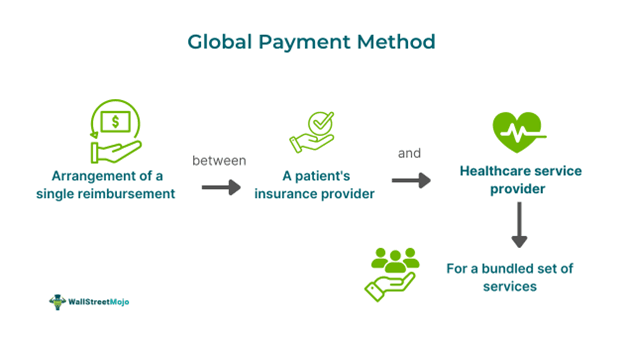The differences between both concepts are given as follows.
Table Of Contents
What Is Global Payment Method?
The global payment method is a reimbursement model in the healthcare revenue cycle management industry. Under this arrangement, providers get a fixed amount as payment for the services they render to a patient in a specified period. The amount is regardless of their actual costs.

The payment model promotes better coordination between insurance companies and healthcare service providers. It improves efficiency in healthcare delivery through proper payments. The main goal of the arrangement is to incentivize healthcare providers and help them deliver care services by controlling costs without compromising on quality. This model is detailed in the global payment method guide, which helps streamline understanding and implementation.
Key Takeaways
- The global payment method is a healthcare payment model for medical billing that is part of revenue cycle management.
- Under this arrangement, a fixed amount is paid to cover all services provided within a particular period. It is reimbursement of expenses without considering the actual service provided or its actual costs.
- It helps in paying employees in the system and motivates them to be productive. Additionally, it supports long-term care, aids in expenditure control, and facilitates better investment in the healthcare field.
Global Payment Method In Medical Billing Explained
The global payment method in healthcare is a payment model used in medical billing and is part of revenue cycle management (RCM). Under this arrangement, a fixed amount is paid to cover all services provided within a specified period. Medical billing refers to the process of creating claims for healthcare services, which are then submitted to insurance companies to secure payments for the services rendered.
Under this arrangement, healthcare services are converted into billing claims. Once approved, these claims ensure payment to the organization as reimbursement for the services provided.
Billing can take a few days or several months. Accurate billing and timely follow-ups are crucial. There are many reasons why this process is important. One such reason is missing claim filing deadlines; it can nullify coverage when missed. Similarly, errors recorded at any stage of the billing cycle can result in a loss of revenue and can increase workload. When the recording and settlement process goes smoothly, it enhances the financial health of the organization and provides financial security for its employees.
Moreover, it helps focus on giving proper care to patients, and since the providers are paid, they have enhanced professional satisfaction. The arrangement works to keep the cost under control and improve efficiency. It becomes more accessible for people in need. Furthermore, it aids in investing in areas of importance.
Examples
Let us look into some examples to understand the concept better.
Example #1
Suppose Dan is an older man who is suffering from back pain. He is suggested for bone replacement surgery, and his healthcare provider has a global payment option. Under this arrangement, the hospital receives a lump sum amount from Dan's insurance provider. This amount is a reimbursement for the costs incurred as a result of the surgery. It includes surgery, preoperative consultations, and recovery period costs. The hospital provides services within the specified amount and avoids unnecessary expenditures or additional services. This approach allows the hospital to focus on what is essential, as they will not receive payment for extra services. It also helps prevent unnecessary spending.
Example #2
The Center for Evidence-based Policy, in its policy brief of September 2022, has listed the advantages and concerns of the payment system, including:
Advantages
- The system of payments helps adequate payment regardless of the patient population through risk adjusting the amounts.
- It offers the flexibility of investment in areas that improve outcomes and reduce costs, such as social services and non-visit-based care.
- It provides healthcare providers with autonomy to attain target resources effectively.
- They encourage a focus on a population's health.
Criticisms
- Improper stratification of the population and the associated risk can be higher.
- If low payments are provided, then providers will favor healthier patients over those who are chronically ill.
- They make tracking of specific services utilization and the associated quality check difficult.
Global Payment Method Vs. Bundled Payment
| Aspect | Global Payment Method | Bundled Payment |
|---|---|---|
| 1. Concept | A predetermined payment method made by a group of providers or systems in healthcare that is paid during a specific time. It is intended to cover most or all of the patient's healthcare during the designated period. | Bundled payments are made to multiple service providers under a single payment. The payment is divided between the providers as they deem fit. |
| 2. Payment receiver | The receiver is typically a single service provider. | There are multiple service providers. |
| 3. Aim | High-maintenance organizations use this method to reduce unnecessary care and bring spending under control. | Bundled payments are used to pay for specific high-volume and high-cost procedures. They provide an incentive for the providers to coordinate the services and find efficient ways to deliver care. |

